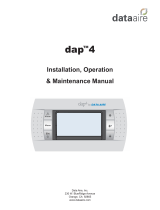
724-746-5500 | blackbox.com
Page 8
Table of Contents
4.5.5.6 Digital In .............................................................................................................................................82
4.5.5.7 Run Hours ..........................................................................................................................................82
4.5.5.8 BMS Communication .........................................................................................................................83
4.5.5.9 Save Configruation .............................................................................................................................83
4.5.5.10 Factory Menu .....................................................................................................................................84
4.6 Communication with the Controller ............................................................................................................................85
4.6.1 Workgroup Setup ............................................................................................................................................85
4.6.1.1 Standby ...............................................................................................................................................86
4.6.1.2 Capacity Assist ....................................................................................................................................86
4.6.1.3 Unit Rotation ......................................................................................................................................86
4.6.1.4 Out of Service .....................................................................................................................................86
4.6.2 Configuring a Workgroup ................................................................................................................................86
4.6.2.1 Configure the Terminal Address .........................................................................................................87
4.6.2.2 Configure the Controller (I/O Board) pLAN Address ..........................................................................88
4.6.2.3 Assign the Terminal to the Controller .................................................................................................88
4.6.2.4 Fault Messages ...................................................................................................................................89
4.6.2.5 Displaying the Network Status and Firmware Version ........................................................................89
4.6.2.6 Configure Workgroups .......................................................................................................................90
4.6.2.7 Service>Options>Group Menu Screens .............................................................................................97
4.6.2.8 Group Information Menu Screens ......................................................................................................99
4.7 BMS Communications ............................................................................................................................................... 101
4.7.1 Direct BMS Control ........................................................................................................................................102
4.7.2 BMS Communication ..................................................................................................................................... 102
4.8 Troubleshooting the Control I/O Module .................................................................................................................. 103
4.9 BMS Parameters, Version 1.2.....................................................................................................................................104
4.9.1 Signed Values for HTTP, SNMP/Modbus Holdling Registers/Analog Values for BACnet ................................105
4.9.2 Unsigned Values for HTTP, SNMP/Modbus Holdling Registers/Analog Values for BACnet ............................106
4.9.3 Boolean Values for HTTP, SNMP/Modbus Coils/Binary Values for BACnet .................................................... 107
4.9.4 Alarm Packed Bit Variables ............................................................................................................................108
4.9.5 Sensor Failure Packed Bit Variables ............................................................................................................... 109
4.9.6 Digital Input Packed Bit Variables ................................................................................................................... 110
4.9.7 Digital Output Packed Bit Variables.................................................................................................................111
4.9.8 Unsigned Values for HTTP, SNMP/Modbus Holding Registers/Analog Values for BACnet ............................. 112
4.9.9 Boolean Values for HTTP, SNMP/Modbus Coils/Binary Values for BACnet .................................................... 112
5. Maintenance ...................................................................................................................................................................... 113
5.1 Periodic General Maintenance ................................................................................................................................... 113
5.1.1 Filters ............................................................................................................................................................. 113
5.1.1.1 Cleanable Filters ................................................................................................................................. 113
5.1.1.2 Cartridge Filters ................................................................................................................................. 115
5.1.2 EC Fans .......................................................................................................................................................... 115
5.1.3 Coil ................................................................................................................................................................ 115
5.1.4 Drain Pans ...................................................................................................................................................... 115
5.1.5 Condensate Pump ......................................................................................................................................... 115
5.1.6 A/C System .................................................................................................................................................... 116
5.2 Troubleshooting ......................................................................................................................................................... 116
5.3 Field Service ............................................................................................................................................................... 119
5.3.1 Water–Water/Glycol System .......................................................................................................................... 119
5.3.2 DX System ..................................................................................................................................................... 119
5.3.2.1 Leak Detection .................................................................................................................................. 119
5.3.2.2 Leak Repair ....................................................................................................................................... 119





















